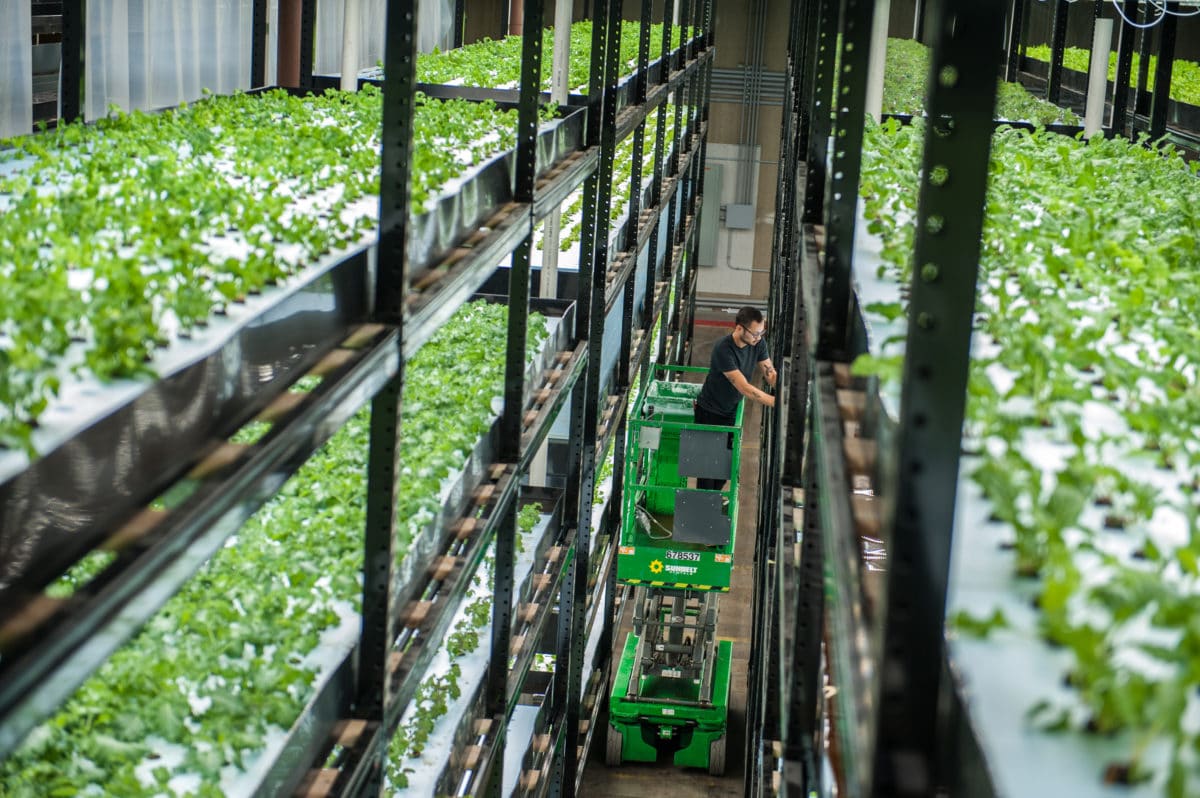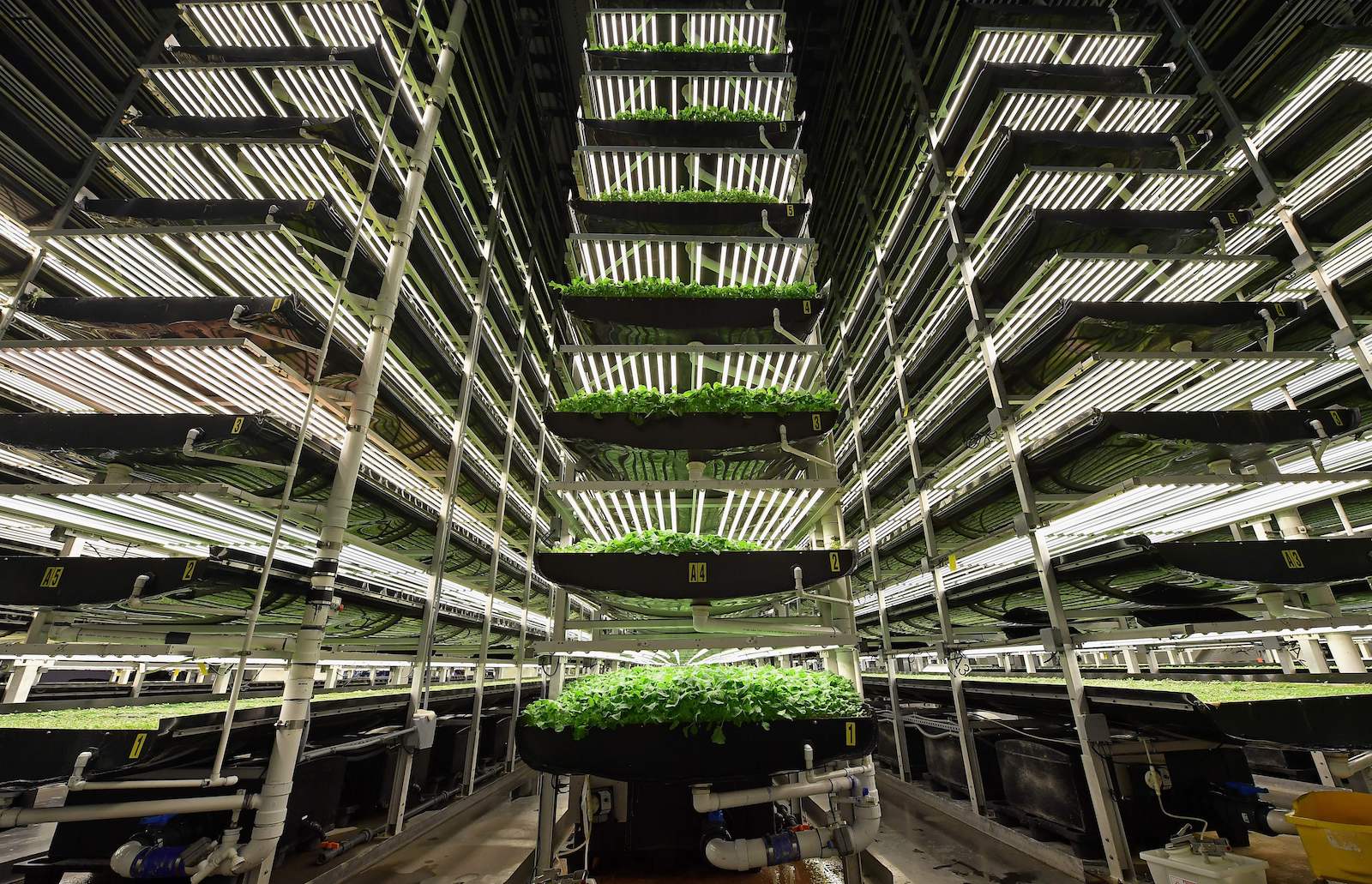are indoor vertical farms really ‘future-proofing agriculture’

As we move into the future, the way we produce our food needs to change. One way in which this change is beginning to unfold is through indoor vertical farming, powered by microgrids and innovative technologies such as hydroponics and aeroponics.
Sustaining the future of indoor vertical farming with microgrids

Indoor vertical farming is a way to grow crops in a controlled environment using artificial lighting, nutrient solutions, and climate controls. It brings a range of benefits, such as higher crop yields, year-round harvests, and reduced water usage.
One of the main challenges of indoor vertical farming is the high energy consumption required to power the lighting and climate control systems. This is where microgrids come into play, as they offer a sustainable solution for powering indoor vertical farms.
A microgrid is a localized power grid that connects multiple energy sources, such as solar panels, wind turbines, and energy storage systems, to serve a small geographical area. By leveraging these alternative energy sources, microgrids can reduce the reliance on the traditional power grid and utilize renewable energy to power indoor vertical farms.
Is Indoor Agriculture the Future of Farming?

Indoor agriculture, which includes vertical farming, is gaining traction in the agriculture industry due to its benefits of producing food locally, year-round, and with fewer resources. In addition, indoor agriculture can be used to grow crops that are not feasible to grow in traditional farming methods due to climate or geography limitations.
Furthermore, irrigation in traditional farming has led to large-scale water usage, but indoor agriculture uses 90% less water than traditional farming methods, making it a sustainable option. The use of pesticides and herbicides to keep pests and diseases from harming crops is also minimized or completely eliminated in indoor agriculture, as a pesticide-free environment is maintained through the use of netted greenhouses or hydroponic water systems.
The Future of Food in Canada

The future of food in Canada lies in indoor vertical farming, where climate control and efficient lighting systems allow for year-round crop production. It allows Canadian farmers to reduce their dependence on weather patterns and increase crop yields, while also reducing the carbon footprint associated with transportation from distant farms.
The use of indoor vertical farming also leads to fresher and more nutritionally dense produce, which is important for maintaining a healthy and balanced diet. In addition, it allows for a wider range of crops to be grown that may not be possible to grow through traditional farming methods.
Abstract
Indoor vertical farming is a forward-looking solution to the challenges of farming in a changing climate. By utilizing sustainable technologies such as microgrids and hydroponics, indoor vertical farms offer a range of benefits, such as higher yields and reduced resource usage, while also reducing the carbon footprint associated with transporting produce from distant farms. Further, indoor vertical farming can be used to grow a wider range of crops, benefiting both farmers and consumers.
Introduction
According to the United Nations, the global population is expected to reach 9.7 billion by 2050, putting immense pressure on the agriculture industry to produce enough food to feed the growing population.
Traditional farming methods face multiple hurdles, including unpredictable weather patterns, soil erosion, and weather-related crop damage. Additionally, large-scale commercial farming requires massive amounts of water and uses nearly 30% of the earth’s total land area. Furthermore, due to aging demographics and the decline of the agriculture industry, younger generations are not opting for careers in this field, resulting in a shortage of skilled workers.
To address these challenges, indoor vertical farming has emerged as a sustainable and efficient alternative to traditional farming, offering a range of benefits for farmers, consumers and the planet as a whole.
Content
The benefits of indoor vertical farming
Indoor vertical farming offers several advantages over traditional farming methods. One of the primary benefits is that indoor farms can accommodate year-round crop production, regardless of weather conditions, thanks to controlled environments with ideal temperature, humidity, and lighting conditions. This allows for high crop yield without seasonal limitations.
In addition, indoor farms utilize less water than traditional farming as they recycle water on site, reducing the water usage by up to 90%. This makes indoor farms a sustainable solution to combat water scarcity issues. Further, it allows farmers to grow crops in areas where access to freshwater is limited.
Furthermore, with indoor vertical farming, the use of chemical pesticides and herbicides, which are often used in traditional farming to preserve crop health, is minimal, if not completely eliminated. Controlled environments prevent pests and diseases, reducing the need for chemical treatments.
Finally, indoor vertical farming enables farmers to grow a wider range of crops, which are not viable through traditional farming methods due to climate or agricultural limitations. This includes medicinal plants, exotic fruits, and specialty herbs, which can be grown in a cost-effective and sustainable manner.
Moving towards sustainable energy with microgrids
The high energy consumption required to power indoor vertical farms has been a major challenge for the industry. However, the integration of microgrids with indoor vertical farming offers a practical solution for powering these farms.
Microgrids are decentralized power systems that can be designed for specific applications by combining various energy resources, such as solar panels and wind turbines, to create a localized and sustainable energy source. By using renewable energy resources, microgrids reduce the reliance on the traditional power grid and allow for the self-sufficiency of indoor vertical farms, driving down energy usage costs and reducing environmental pollution.
Furthermore, microgrids offer resilience to local power outages, ensuring safe and reliable energy supply and preventing crop loss in the event of a power blackout.
Aquaponics and aeroponics: revolutionizing indoor agriculture
Indoor vertical farming also includes innovative technologies such as aquaponics and aeroponics.
Aquaponics is a system that integrates hydroponics and aquaculture. In this system, the fish waste is converted into nutrient-rich water that is used to feed the crops in hydroponic containers. The crops, in turn, act as a natural filter for the water, which is then returned to the fish tank, creating a self-sustaining ecosystem. This system reduces water usage by over 90% compared to traditional farming methods and eliminates the need for synthetic fertilizers and pesticides.
Aeroponics, on the other hand, involves suspending plants in air and spraying the roots with nutrient-rich mist, creating a humid environment ideal for plant growth. This system reduces water consumption by up to 95% and allows for faster-growing and larger harvests.
Conclusion
Indoor vertical farming is quickly gaining momentum as a sustainable and efficient alternative to traditional farming methods. It offers a range of benefits, such as higher yields, year-round production, and reduced resource usage.
Through the integration of innovative technologies such as microgrids, aquaponics, and aeroponics, indoor vertical farming offers a practical and scalable solution to address global food security challenges, and with the added benefits of reducing environmental pollution and promoting sustainable agriculture practices. Furthermore, by assisting the farming industry in moving towards sustainable energy sources, microgrids can make a significant contribution to reducing greenhouse gas emissions and slowing down climate change.
The future of food production lies in indoor vertical farming, and it has the potential to revolutionize the agriculture industry and feed a growing population sustainably and efficiently.

Source image : signatureelectric.ca

Source image : www.brinknews.com

Source image : pv-magazine-usa.com




